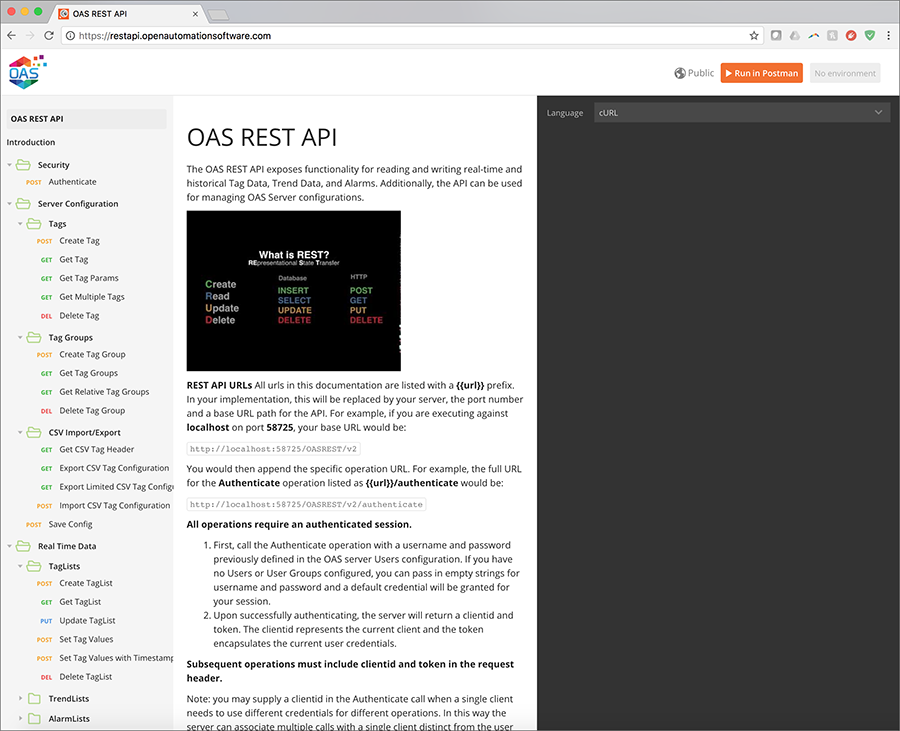Read and Write OAS Data over HTTP
Not only does the REST API expose operations for reading and writing both real time and historical data, it allows developers to create applications to automate the configuration of the OAS service itself.
Are you new to REST APIs? Learn more in our article "What is REST?"
a server-based, highly-scalable, network platform that enables the transport and transformation of your data
Data HistorianAchieve fault-tolerant logging, zero data loss, and multi-destination storage with our high-performance Store and Forward technology.
Visualization ToolsBuild Visualizations, User Interfaces, and server configuration interfaces for .NET, web technologies, native iOS and Android mobile apps
Device & Data ConnectorsThe OAS Platform provides rapid communications and connectivity to a wide variety of PLCs, devices, and databases.
IoT ConnectorsConnect to cloud-base IoT gateways such as AWS, Azure IoT Hub, Azure Event Hubs, Kafka, and more.
Alarm Logging & NotificationCapture events on each data point, log to open formats for historical analysis and archiving, and trigger real time notifications
SDKs & APIsExplore a wide variety of Developer Tools and APIs to allow you to create applications and system integrations to execute in any environment.
Networking FeaturesOpen Automation Software implements edge computing with a Distributed Network Architecture.
Download a fully functional trial of Open Automation SoftwareKey Features & Benefits
Near Universal Support
Simple, efficient API, fully documented, and supported by virtually every programming language and platform.
Based on Standards
Utilizes widely accepted REST standards using JSON over HTTP, and supports HTTPS(TLS) for secure communications.
When to use the OAS REST API
Building custom HMIs or user interfaces that consume OAS tag data, on any platform and on any network.
Perfect for supplying data into an OAS Server from external non-standard sources such as:
- Mobile devices
- Arduino, RaspberryPI, or other IoT components
- Proprietary systems
- Creating a common interface between disparate application platforms such as Python, Java, PHP, .NET, NodeJS, or any other environment capable of issuing HTTP calls
- Automating OAS Server configuration and deployment
The OAS REST API includes endpoints for reading and writing live and historical data, but also provides endpoints for OAS server configuration. Building the solution that meets your unique requirements could not be simpler.

Common Use Cases
Integration with virtually every platform
The OAS REST API is based on standards such as HTTP and JSON, so integration with virtually every programming language on any platform is a natural fit.
Public API integration
Many online services expose a REST API as well, so you can write code to read data from a public API, e.g. weather or geo data services, parse the data and write to the OAS REST API for use within OAS Tags.
Custom User Interfaces
In some cases, your solution requires a custom user interface, or may have an existing code base. You can make REST API calls to pull live data into your UI and drive your interface on any platform, including mobile devices.
Learn how thousands of customers are using the OAS Product Platform around the globe to achieve truly open industrial automation
24/7/365
Support
Technical support available by phone, chat, and email
30+ Years
Experience
Product efficacy, market testing, and reliability
Used in 10K+
Data Servers
OAS is used in thousands of businesses worldwide
See How We Compare
The initial cost of OAS is far less than our competitors – but the savings don’t stop there. We work with OEMS and System Integrators to provide perpetual licenses with quantity discounts with flexible tag pricing and unlimited client connections.
No Question Left Unanswered
We make getting started with OAS easy - Follow this step-by-step introduction to using the Open Automation Software platform, from selecting your data sources, product features, and data destinations.
Getting Started - Download, Setup & Support
Step-by-step introduction to using the Open Automation Software platform
How to manually add and define Tags using the Configure OAS application.
Familiarize yourself with the REST API following steps to setup your first interface.
A basic primer on JSON, the basis for all data structures passed in REST API calls.
A list of step by step tutorials for integrating REST API into your own solutions.
Interactive OAS REST API documentation with examples of each call and integrated with Postman for live testing.
More about the 3 key networking methods included with licenses.
How to quickly access options and make custom changes.
How to active and manage OAS license.




